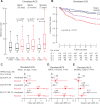Gut microbiota-dependent trimethylamine N-oxide in acute coronary syndromes: a prognostic marker for incident cardiovascular events beyond traditional risk factors
- PMID: 28077467
- PMCID: PMC5837488
- DOI: 10.1093/eurheartj/ehw582
Gut microbiota-dependent trimethylamine N-oxide in acute coronary syndromes: a prognostic marker for incident cardiovascular events beyond traditional risk factors
Abstract
Aims: Systemic levels of trimethylamine N-oxide (TMAO), a pro-atherogenic and pro-thrombotic metabolite produced from gut microbiota metabolism of dietary trimethylamine (TMA)-containing nutrients such as choline or carnitine, predict incident cardiovascular event risks in stable primary and secondary prevention subjects. However, the prognostic value of TMAO in the setting of acute coronary syndromes (ACS) remains unknown.
Methods and results: We investigated the relationship of TMAO levels with incident cardiovascular risks among sequential patients presenting with ACS in two independent cohorts. In the Cleveland Cohort, comprised of sequential subjects (n = 530) presenting to the Emergency Department (ED) with chest pain of suspected cardiac origin, an elevated plasma TMAO level at presentation was independently associated with risk of major adverse cardiac events (MACE, including myocardial infarction, stroke, need for revascularization, or death) over the ensuing 30-day (4th quartile (Q4) adjusted odds ratio (OR) 6.30, 95% confidence interval (CI), 1.89-21.0, P < 0.01) and 6-month (Q4 adjusted OR 5.65, 95%CI, 1.91-16.7; P < 0.01) intervals. TMAO levels were also a significant predictor of the long term (7-year) mortality (Q4 adjusted HR 1.81, 95%CI, 1.04-3.15; P < 0.05). Interestingly, TMAO level at initial presentation predicted risk of incident MACE over the near-term (30 days and 6 months) even among subjects who were initially negative for troponin T (< 0.1 ng/mL) (30 days, Q4 adjusted OR 5.83, 95%CI, 1.79-19.03; P < 0.01). The prognostic value of TMAO was also assessed in an independent multicentre Swiss Cohort of ACS patients (n = 1683) who underwent coronary angiography. Trimethylamine N-oxide again predicted enhanced MACE risk (1-year) (adjusted Q4 hazard ratios: 1.57, 95% CI, 1.03-2.41; P <0.05).
Conclusion: Plasma TMAO levels among patients presenting with chest pain predict both near- and long-term risks of incident cardiovascular events, and may thus provide clinical utility in risk stratification among subjects presenting with suspected ACS.
Keywords: Acute coronary syndrome; All-cause mortality; Choline; Gut microbiota; Incident major adverse cardiac events; Risk stratification; Trimethylamine N-oxide.
Published on behalf of the European Society of Cardiology. All rights reserved. © The Author 2017. For permissions, please email: journals.permissions@oup.com.
Figures



Comment in
-
Acute coronary syndromes: Microbial-dependent TMAO as a prognostic marker in ACS.Nat Rev Cardiol. 2017 Mar;14(3):128-129. doi: 10.1038/nrcardio.2017.10. Epub 2017 Jan 27. Nat Rev Cardiol. 2017. PMID: 28127030 No abstract available.
-
Gut microbiota and acute coronary syndromes: ready for use in the emergency room?Eur Heart J. 2017 Mar 14;38(11):825-827. doi: 10.1093/eurheartj/ehx005. Eur Heart J. 2017. PMID: 28159962 Free PMC article. No abstract available.
References
-
- Koeth RA, Wang Z, Levison BS, Buffa JA, Org E, Sheehy BT, Britt EB, Fu X, Wu Y, Li L, Smith JD, DiDonato JA, Chen J, Li H, Wu GD, Lewis JD, Warrier M, Brown JM, Krauss RM, Tang WH, Bushman FD, Lusis AJ, Hazen SL.. Intestinal microbiota metabolism of L-carnitine, a nutrient in red meat, promotes atherosclerosis. Nat Med 2013;19:576–585. - PMC - PubMed
Publication types
MeSH terms
Substances
Grants and funding
LinkOut - more resources
Full Text Sources
Other Literature Sources
Molecular Biology Databases

